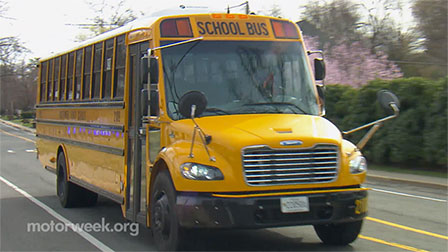March 30, 2022
Electric School Buses Clear the Air in the Mid-Atlantic (Text Version)
This is a text version of the video segment Electric School Buses Clear the Air in the Mid-Atlantic, which aired on March 30, 2022.
JOHN DAVIS: These days, it seems like every automaker offers a plug-in electric model. Well now, we’re seeing an upturn in the number of larger passenger vehicles making that EV switch too. So, for millions of school students, that means their ride to school is about to get cleaner and quieter.
Nearly every day, in virtually every community and neighborhood around the country, 500,000 yellow buses hit the streets, transporting 26 million children to and from school. Taken as a whole, school buses make up the nation’s largest public transportation network, but about 95% of those buses run on diesel fuel. That puts the most vulnerable members of our populace at risk for respiratory problems and other issues linked to breathing exhaust fumes.
The recent growth of electrification for cars and trucks presents an opportunity to change that, and the recent infrastructure law includes two and a half billion dollars in federal aid, specifically to help school districts purchase zero emission electric school buses and an equal amount for other low emission and electrified vehicles.
But making the electric switch requires education for those who will manufacture, purchase and use those buses, and that’s where programs like MEEP come into play. MEEP is the Mid-Atlantic Electric School Bus Experience Project, spearheaded by the Virginia Clean Cities coalition and begun with funding from the US Department of Energy in 2019.
MEEP is working with bus manufacturers, school districts, and other partners to provide hands-on experience and extended demonstration loans of electric school buses to school bus fleets throughout Virginia, Maryland, DC, Pennsylvania, and New Jersey over the next two years.
ALLEYN HARNED: We’ve kicked off the program and already done more than twenty successful demonstrations, as well as six virtual events. This has led to the deployment of 100 electric school buses within the region.
JOHN DAVIS: This bus, known as Jouley, is manufactured by Thomas Built Buses in North Carolina, using an electric propulsion system developed by Proterra, and already proven through 8 million service miles on electric transit buses across America. Jouley has a driving range of about 138 miles and can recharge in just 3 hours using a DC fast charger.
JIM BEASLEY: Well, the routes that it runs. It runs in the AM and the PM mostly, predominantly. They’re easy to charge because there’s downtime in between, and they’re sitting overnight. They’re quiet, they run through the neighborhoods, and they’re non-polluters.
JOHN DAVIS: The electrification of school buses is gaining a groundswell of support from community leaders, parents and the students themselves.
SPEAKER: I am so proud of our students and the awareness they have, and they know now is the time to take the environmental legacy into their hands.
PAUL D’ANDRADE: And the main thing is about our kids, you know. We want them to have the opportunity to have zero emission buses, to have a nice quiet ride, and less effects on their health.
Our total amount of buses is just over 1600. We have eight electric buses, and we have ten we should get sometime next school year, and we put in the application for another grant for an additional ten.
JOHN DAVIS: Electrifying our nation’s school bus fleet won’t happen overnight. That two and a half billion dollars is expected to add about 10,000 electric buses to the national total over the next five years; but it’s an investment that will continue to pay huge dividends in awareness and one that will drive us towards a cleaner future for generations to come.

